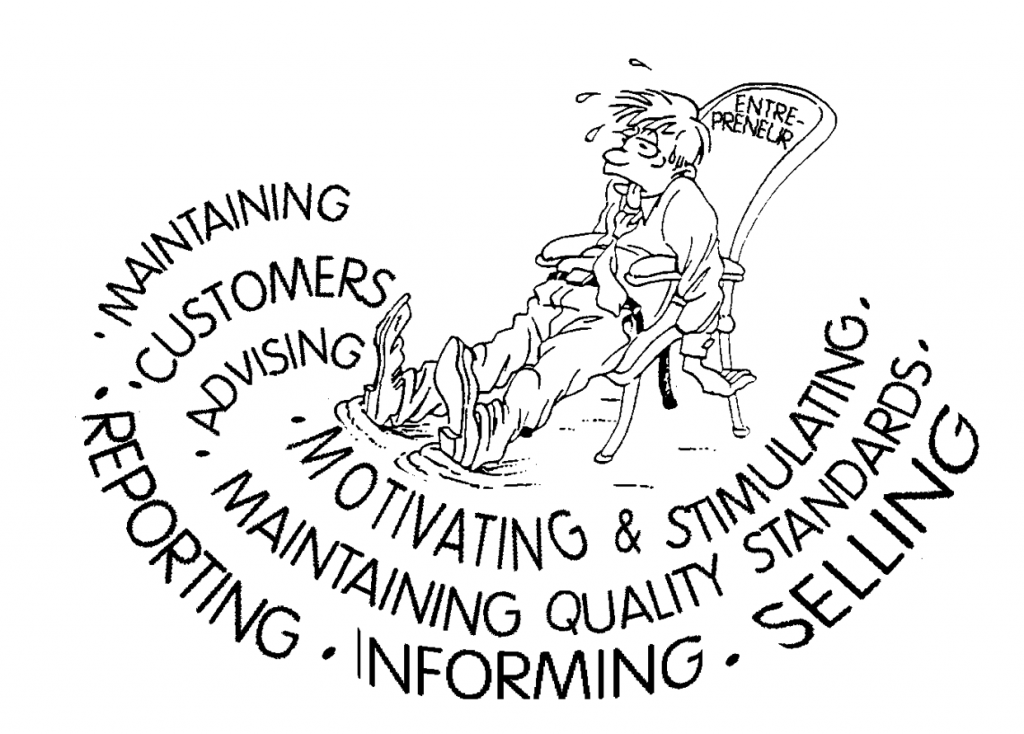Weekday, September. It’s just gone 6 pm, and you’re walking home. Virtually all shops are closed, the lights are switched off. Apart from one. An insurance broker. The lights are still switched on. The atmosphere is electric yet relaxed. The phone is ringing: incoming queries on saving schemes, health insurance policies and other autumn promotions. How come the lights are still switched on in this office, while all the others have gone home? Where does this enthusiasm stem from? How can you motivate your employees to do that little bit extra?
The most difficult task for you, the manager, is undoubtedly influencing the activities of your employees. Why is it difficult? Because the driving force compelling people to carry out certain tasks differs per person. The way in which each person deploys his capabilities, depends heavily on his motivation.

What is motivation?
Motivation does not exist in isolation. There are always motives driving people to decide whether to do or not do something. Motivation is therefore always aimed at achieving a goal, be it to gain recognition, push for a salary rise, or acquire a new customer. If you are able to identify the motivation (driving force) of your employees, you will gain an insight into their behaviour. This is not an easy task, however, as everyone is driven by different motives, which could clash with those of others. An additional problem is that people are not always aware of their actual motives.
Motives for working overtime can differ per employee. Employee A may need the money for home improvements, while employee B may be looking for a positive appraisal to enhance his chances of promotion at the end of the year. In addition to these different, contradictory and subconscious needs, there are also varying degrees of motivation. The degree of motivation depends on:
- The values an individual attaches to the goal that he may achieve. For example: Two of your employees are eligible for promotion. This promotion means that customers will often have to be visited in the evening. This poses no problems for Mr. Nilssen., Mr. Johnson, on the other hand, decides not to go for promotion for this very reason. Mr. Nilssen therefore attaches a different value to the goal (promotion) than Mr. Johnson.
- Chance of success.
For example: You propose that one of your best employee is put in charge of office staff. The employee in question turns down this chance of promotion however, as she does not wish to take the risk of failing in her new challenge. What is the reason for this fear of failure? Research has shown that employees work the hardest if they believe their chance of success/failure is fifty-fifty. Only then do they believe they are actually in a position to influence his chance of success. The employee in the above example pitched her chance of success at less than 50%. - Mental and physical constitution.
For example: A sick employee will be less motivated than a fit employee.
The pyramid of Maslow
Although most of the activities carried out by your employees are goal-oriented, establishing why they do what they do is no easy task. Extensive research has been carried out to map out motivation. One of the best known is the needs pyramid of Maslow. Maslow bases his research on the assumption that human beings are organisms with needs, which create tension. In order to reduce that tension, humans start displaying certain behaviour, aimed at reducing tension. Once a certain need has been satisfied, it will make way almost immediately for another need. This process is never-ending; humans will continue making an effort to satisfy their (new) needs. The hierarchy in the needs structure indicates that a higher need will not stimulate humans to act, until a lower need has been satisfied.
The importance of pyramid of Maslow
How does this theory affect you, the manager? As an inspiring leader, you need to have an insight into the needs and/or motivations of your employees, to direct their activities to achieve the aims and objectives set by your company or department. If someone is uncertain of about the (extension) of the employment contract (security/certainty), the relationship with his employees (social needs) is less relevant at that particular moment.
If, on the other hand, contacts are going well, many will strive for recognition (ego needs). Now that I have been given sufficient recognition in my position as salesman (car, car telephone, visiting cards), my next aim is to develop further: new challenges in the form of new actions, offering new and challenging products can provide the solution in this respect.
Causes of Demotivation
How come some people put all their efforts into their work (are motivated), while others cut corners? In order to answer this question, you do well to pay attention to the everyday procedures in your company or department, which may have a demotivating effect on your employees. Recurring demotivating issues need to be tackled, before employees can be motivated. At the outset, people cannot be motivated, only demotivated.
Causes of demotivation include:
- Policy lacks clarity: What are we going to do in the next few years?
- Organisational structure lacks clarity: Who is responsible for what?
- Lack of clarity concerning employment: Shall we or shan’t we open a sub office?
- Long-term conflicts: I refuse to work with…..
- Measures too strict: Agreed, he was in the wrong, but to attack him like that….
- Lack of proper consultation: If I was consulted, I would….
Management style and motivation
Why do some managers manage to motivate, while others fail, even though it appears to be a comparable situation? This has everything to do with your management style. Not every management style is effective in every situation. There is no such thing as a universal approach, that will create the best results in all circumstances. Managers, whose style of leadership is tuned to the behaviour of his employees, will usually succeed best in motivating his people. We will discuss the Dominant, Reserved, Social and Stable management style.
Dominant management style
A Dominant management style is primarily task-oriented and not focussed on the relationship. Securing orders is of greater importance to you, than the wellbeing of your people. A dominant manager takes a lot of initiatives and invests a lot of energy in steering, guiding and checking performances. He will not tolerate criticism and is a bad loser.
This management style has a motivating effect on people who are unable to tackle issues independently. This approach is especially suited to new employees, or departments that are performing badly.
This manager motivates because he is:
- Determined
- Bold
- Communicates the tasks and authorities clearly
- Adopts the ‘carrot and stick’ approach
- Makes calculations in terms of time and money
- Is focussed on results
This manager demotivates because he is:
- Always decides everything himself
- Fails to delegate
- Only gives negative criticism
- Never listens to criticism
- Suppresses conflicts
- Demands 100 % obedience
- Communications in one-way traffic
Reserved management style
The Reserved manager is both task-oriented and focused on the relationship. He gives detailed instructions, but mostly leaves it up to his people to carry out the instructions; he is responsible for delegating tasks. This style has a motivating effect if applied to existing teams who already possess a number of basic skills, but still have a lot to learn.
The reserved manager motivates his people by acting as a mentor. He teaches his people to interpret his expectations, how the organisation works, and helps them achieve more self-confidence. He also motivates because he is:
- Reliable
- Observes procedures
- Transfers expertise
- Follows up orders
- Keeps the work interesting
- Listens to, and uses the advice issued by his employees
This manager demotivates if he:
- Does no more than is necessary
- Acts defensively
- Is not very receptive to change
- Adopts too individualistic an attitude
- Always considers procedures more important than the wishes of his people
- Is too focused on detail
The Social management style
The Social management style characterises managers who are focussed on their relationships. People come first. This manager attaches great importance to moral and creating a pleasant working environment. Instructions are kept to a minimum. This management style has a motivating effect on employees with highly developed technical skills, high levels of input and creativity, and employees who are fully able to determine which work methods to use.
The social manager acts as a coach, and helps his employees achieve their desired goals. He also motivates his employees through his:
- Informal, sympathetic attitude
- Ability to give his people confidence and trust
- Ability to be open
This manager demotivates if he:
- Avoids conflicts
- Always tries to gain the acceptance of others
- Fails to give direction
- Fails to exercise any control whatsoever
- Makes it easy for others
- Has absolutely no eye for results
The Balanced manager
The Balanced manager is able to apply the correct management style in any given situation, depending on:
- The people he has to lead
- The demands imposed by the organisation
- The product for which he is responsible
In practice, this means that certain situations demand a Dominant style, while others require a Social style.
This manager:
- Exercises authority through his ideals and objectives
- Is interested in the motivational aspects of work
- Has the necessary skills to motivate others
- Places great importance on teamwork
Different groups of people are motivated by different management styles. A young, inexperienced team needs a dominant leader. If you are dealing with a group of extremely experienced people, a Social style is probably most suitable.
As a motivating manager, you need to develop a feel for the wishes and needs of your people, enabling you to react in a flexible way. You are the motivating factor!
Motivation tools
Motivating people is always a difficult task. People are motivated in different ways. You are the biggest motivating factor. You set the right example. Motivating is made a whole lot easier when you use so-called motivation tools, which can be applied at any time of the day.
- Communicate your expectations to your people
- Ensure that your people are well informed
- Put your people in control
- Give your people responsibility
- Turn your people into champions
- Give feedback to your people
- Reward your people
- Help your people to learn and grow
- Ensure that you are easily contactable
- Be critical of your management style
Use your motivation checklist to establish in which areas you are motivating your employees, and in which areas your management style can still be improved on. Motivation drives your success. If you assume that 80% of people motivate themselves, your most important task is to establish what is preventing people from functioning optimally.
Look for possible causes, fret over it, discuss it with your employees, think about it and clear up hindrances/bottlenecks. Your team will thank you for it. Your customers will experience it. Your results will improve.



